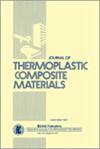Investigating the influence of annealing and nozzle diameter on tensile strength of polyethylene terephthalate glycol composites
IF 3.4
4区 材料科学
Q2 MATERIALS SCIENCE, COMPOSITES
引用次数: 0
Abstract
Additive Manufacturing (AM) techniques, particularly Fused Filament Fabrication (FFF), have revolutionized prototyping and low-volume production. Improving the tensile properties of FFF-printed parts is a primary objective to elevate their functional utility. This study aimed to investigate the effects of annealing time (ATM), annealing temperature (ATP), and nozzle diameter (ND) on the tensile strength (TS) of two commonly used printing materials: Polyethylene Terephthalate Glycol (PETG) and PETG reinforced with carbon fibre (PETG-CF). Samples with varying ND (0.4 mm, 0.6 mm, and 0.8 mm) underwent annealing at ATP of 80°C and 100°C for ATM of 60 min and 120 min, respectively. Subsequent tensile tests were meticulously conducted, and regression models were employed to comprehensively analyse the influence of these control factors on TS. The findings from the tensile tests on annealed specimens revealed substantial improvements in TS for both PETG and PETG-CF materials. Statistical analysis, Taguchi method (TM), and response surface methodology (RSM) indicated that ND exerted a more pronounced impact on TS compared to ATM and ATP. By identifying the optimal control factor combinations for each material, the study pinpointed that the best TS was achieved at 0.8 mm ND, 120 minutes ATM, and 100°C ATP for PETG-CF. The remarkable enhancement in tensile properties for annealed FFF-printed parts underscores the potential of PETG-CF to replace structural metallic components in critical applications within the automotive and aeronautical industries.研究退火和喷嘴直径对聚对苯二甲酸乙二醇酯复合材料拉伸强度的影响
增材制造(AM)技术,尤其是熔融长丝制造(FFF)技术,为原型制造和小批量生产带来了革命性的变化。改善 FFF 打印部件的拉伸性能是提高其功能实用性的首要目标。本研究旨在调查退火时间(ATM)、退火温度(ATP)和喷嘴直径(ND)对两种常用打印材料拉伸强度(TS)的影响:聚对苯二甲酸乙二醇酯(PETG)和碳纤维增强 PETG(PETG-CF)。不同 ND(0.4 毫米、0.6 毫米和 0.8 毫米)的样品分别在 80°C 和 100°C 的 ATP 温度下退火 60 分钟和 120 分钟。随后进行了细致的拉伸试验,并采用回归模型全面分析了这些控制因素对 TS 的影响。对退火试样进行拉伸试验的结果表明,PETG 和 PETG-CF 材料的 TS 均有大幅提高。统计分析、田口法(TM)和响应面法(RSM)表明,与 ATM 和 ATP 相比,ND 对 TS 的影响更为明显。通过确定每种材料的最佳控制因素组合,研究发现 PETG-CF 在 0.8 mm ND、120 分钟 ATM 和 100°C ATP 时达到最佳 TS。退火 FFF 印刷部件拉伸性能的显著提高凸显了 PETG-CF 在汽车和航空工业关键应用中替代金属结构部件的潜力。
本文章由计算机程序翻译,如有差异,请以英文原文为准。
求助全文
约1分钟内获得全文
求助全文
来源期刊

Journal of Thermoplastic Composite Materials
工程技术-材料科学:复合
CiteScore
8.00
自引率
18.20%
发文量
104
审稿时长
5.9 months
期刊介绍:
The Journal of Thermoplastic Composite Materials is a fully peer-reviewed international journal that publishes original research and review articles on polymers, nanocomposites, and particulate-, discontinuous-, and continuous-fiber-reinforced materials in the areas of processing, materials science, mechanics, durability, design, non destructive evaluation and manufacturing science. This journal is a member of the Committee on Publication Ethics (COPE).
 求助内容:
求助内容: 应助结果提醒方式:
应助结果提醒方式:


